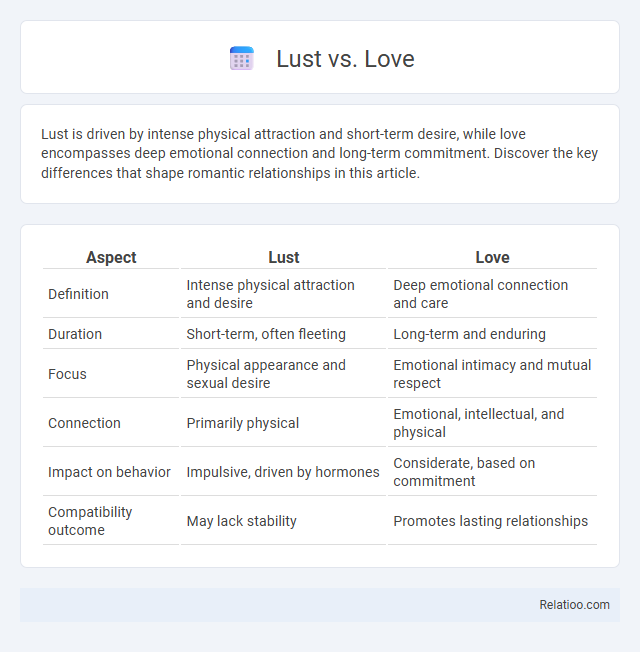Lust is driven by intense physical attraction and short-term desire, while love encompasses deep emotional connection and long-term commitment. Discover the key differences that shape romantic relationships in this article.
Table of Comparison
| Aspect | Lust | Love |
|---|---|---|
| Definition | Intense physical attraction and desire | Deep emotional connection and care |
| Duration | Short-term, often fleeting | Long-term and enduring |
| Focus | Physical appearance and sexual desire | Emotional intimacy and mutual respect |
| Connection | Primarily physical | Emotional, intellectual, and physical |
| Impact on behavior | Impulsive, driven by hormones | Considerate, based on commitment |
| Compatibility outcome | May lack stability | Promotes lasting relationships |
Understanding the Concepts: What is Lust vs Love?
Lust is characterized by intense physical desire and sexual attraction driven primarily by hormones like testosterone and dopamine, often lacking emotional depth or long-term commitment. Love involves deep emotional connection, attachment, and mutual care, engaging brain areas linked to bonding such as the oxytocin and vasopressin systems. Attraction can include both physical and emotional elements, serving as the initial spark that may develop into either lust or love depending on psychological and biochemical factors.
Key Psychological Differences Between Lust and Love
Lust centers on intense physical desire driven by hormones like testosterone and dopamine, triggering a rapid but short-lived emotional response. Love involves deeper psychological connections, including attachment and commitment mediated by oxytocin and vasopressin, fostering long-term bonding and trust. Understanding these key psychological differences helps you navigate relationships by distinguishing fleeting passion from enduring emotional intimacy.
Physical Attraction: The Spark of Lust
Physical attraction serves as the initial spark of lust, driven primarily by visual and sensory stimuli that ignite your desire. This intense, immediate response often prioritizes appearance, chemistry, and physical features rather than emotional connection or long-term compatibility. Lust can be a powerful force that fuels passion but typically lacks the depth and commitment found in love.
Emotional Connection: The Heart of Love
Emotional connection forms the core of love, distinguishing it from lust and mere attraction by fostering deep trust, empathy, and understanding between partners. While lust is driven primarily by physical desire and attraction by initial fascination, love develops through shared experiences and emotional bonding that nourish your relationship over time. Strengthening this connection transforms fleeting feelings into lasting intimacy and commitment.
Hormones Involved: Lust vs Love in the Brain
Lust primarily involves the hormone testosterone, which drives the desire for sexual gratification by stimulating the brain's reward system. Love, on the other hand, is regulated by oxytocin and vasopressin, which promote bonding, trust, and long-term attachment between partners. Dopamine and serotonin also play significant roles in both lust and love by influencing pleasure and mood, but oxytocin's release during intimate moments distinctly strengthens emotional connection beyond mere attraction.
Signs You’re Experiencing Lust, Not Love
Intense physical desire, obsessive thoughts about appearance, and a rush of excitement often signal lust rather than love. If Your feelings fade quickly once physical closeness or novelty diminishes, it indicates attraction is driven by lust, not deep emotional connection. Recognizing these signs can help differentiate fleeting passion from lasting love.
How True Love Develops Over Time
True love develops gradually as emotional intimacy deepens and mutual understanding strengthens between partners, moving beyond initial lust or physical attraction. Unlike fleeting attraction driven by appearance or hormones, love is built on trust, shared experiences, and consistent support over time. Neurochemical changes involving oxytocin and dopamine foster bonding, reinforcing attachment and long-term commitment.
Lust and Love in Modern Relationships
Lust often drives the initial physical desire in modern relationships, characterized by intense passion and a focus on immediate gratification. Love, in contrast, builds over time through emotional intimacy, trust, and deep connection, fostering long-term commitment and mutual support. Your understanding of these distinctions can help navigate relationship dynamics more effectively and cultivate lasting bonds.
Navigating Relationships: Balancing Lust and Love
Navigating relationships requires understanding the distinct roles of lust, love, and attraction, as lust often ignites initial desire while love fosters deep emotional connection. Your ability to balance physical attraction with genuine emotional intimacy ensures healthier, more sustainable partnerships. Prioritizing communication and self-awareness helps distinguish fleeting lust from profound love, guiding meaningful relationship growth.
Choosing Wisely: Building Lasting Connections
Lust, love, and attraction each play distinct roles in human relationships, with lust driven by physical desire, attraction influenced by emotional and psychological factors, and love encompassing deep commitment and connection. Choosing wisely involves recognizing the fleeting nature of lust and prioritizing the meaningful bond of love to build lasting connections that withstand challenges. By understanding these differences, you can foster relationships that offer genuine fulfillment and enduring happiness.

Infographic: Lust vs Love
 relatioo.com
relatioo.com